Wheel
![]()
The title of this article is ambiguous. For other meanings, see Wheel (disambiguation).
The wheel is a disc-shaped object with an ideally circular contour, mounted to rotate about an axis perpendicular to the idealized circular plane, and most commonly used as a cart wheel. Its invention and use on carts or wagons was an important event in the development of technical culture in prehistory.
Of significant advantage is the rolling of its circumference on the substrate. Sliding only takes place in the lubricated bearings. The rolling resistance on firm, dry ground and the sliding resistance in the bearings are together much smaller than the sliding resistance when using a bar loop or a sledge to transport a load over dry ground. Material abrasion is also less than with dragging. Vehicles and teams with wheels and draft animals became the readily available and durable means of transport in prehistory and early history for loads and people.
Already during the Bronze Age, the wheel was further developed from the disc to the lighter spoke wheel. The spoke shape was created by replacing parts of the disc between the hub and the outer rim of the wheel with pressure- or traction-resistant, often more special materials and an often sophisticated joining technique.
The simple machine elements include the wheel that only rotates (for example, handwheel, steering wheel). Today, a vehicle wheel is a complex technical component.
Rad (nhd. and ahd.) is related to Latin rota and the Sanskrit word ratha, "chariot".

Cannon from the Thirty Years' War with metal-shod wheels

Wooden disc wheel

Handcart (two-track, single-axle) with wooden spoked wheels
History
For a long time, the Sumerian culture was considered to be the origin. Today, the dating of finds or representations of chariots and wheels from Central Europe and Eastern Europe as well as from Mesopotamia for the middle of the 4th millennium BC are close to each other. A more precise chronological and local classification of the invention is not yet possible. In pre-Columbian America and Australia, the wheel was unknown as a means of transport.
Somewhat earlier, or at the same time, the rapidly rotating potter's wheel, also equipped with plain bearings, became known. An indication that the machine element of plain bearings was now well mastered: Lubrication and low clearance.
Older transport equipment
The first transport devices with which loads could be transported on land without carrying them were sledges and pole bows. With the loop, however, part of the load and the construction weight must be carried, it had as an advantage over other means of transport a good cross-country mobility. When using sledges and bar loops, a high sliding resistance usually had to be overcome. Transport on rollers or rolls was only possible on well-prepared ground and short distances. There is evidence of rolling transport from Bronze Age Egypt. The disadvantage was that the rollers had to be laid out over the entire distance or repeatedly removed at the back and placed in front of the object to be transported again. But it was possible to shift comparatively heavy loads, as these were distributed over a larger area than was present in the sliding bearings of the later wheel. Roller transport is still used today for special purposes such as the relocation of buildings or extreme loads over short distances.
Oldest evidence of the wheel
The rotatably mounted wheel, i.e. "infinitely" rotatable around an axis, could be made with stone tools. Apparently, in the 5th millennium BC, potters on the Indus were the first to apply this principle in the production of ceramics as potter's wheels.
The oldest evidence is found in the form of miniature wheels made of clay north of the Black Sea already before 4000 B.C. The evidence thickens from the middle of the 4th millennium onwards throughout Europe in the form of chariot models. Further indirect evidence of use as a chariot wheel was found, for example, in the form of carvings on a vessel from the Funnel Beaker Culture at Bronocice near Powiat Pińczowski (Poland). Another indirect evidence is a track from the middle of the 4th millennium BC in a mound bed near Flintbek (Rendsburg-Eckernförde district).
The first direct finds of carts, wheels, wagons or their models date from the second half of the 4th millennium BC in Europe, e.g. within the framework of the Funnel Beaker Culture and the Baden Culture, in the Alpine foothills, in the northwestern Caucasus (Maikop Culture), as well as in Mesopotamia and the Near East. These were single or multi-piece disc wheels with diameters between 40 and 80 cm, with fixed, loose or without hub bush or fixed axle (and square axle holes). The oldest finds were predominantly two-axle vehicles. The finds either originate from burials in wagon graves or are bog finds.
The oldest well-dated wheel-axle combination comes from Stare Gmajne in the Laibacher Moor near Ljubljana in Slovenia, whose wheel in the 2σ-range was dated to 3340-3030 cal BC, the axle to 3360-3045 cal BC. A slightly younger wheel was found in the Federseemoor at Seekirch-Achwiesen. It is about 5000 years old and is composed of two parts.
The remains of two chariots were excavated in eastern Georgia under a burial mound in Ananauri (Kakheti region) and dated to c. 2400 ± 150 BC. This kurgan probably belongs to a leader of the last phase of the Kura-Araxes culture, which has clear connections with the Maikop culture. More detailed investigations are still pending. In addition to obsidian and flint, the grave also contained amber beads. This supports the thesis that the chariot came from the northern region long before the horse and took its way south with the spread of the Kura-Araxes culture.
The dating of the sites does not currently allow a decision to be made on a place of origin for the wheel and chariot technology.
Traces of use
One of the four disc wheels from Glum from the Bronze Age had a scuffing groove that was not incorporated on the entire turning circle. It was caused by the wagon body wearing down the crooked ("egg-shaped") wheel. A shorter groove on the other side shows that the wheel was also turned. The edge of the tread was beveled or rounded. Some partial surfaces were so well preserved that smoothing strokes of a tool are recognizable. The wheel, made of alder wood, belonged to a wagon whose front axle could not swivel. When changing the direction of travel, the draught animals dragged the front carriage to the side until the drawbar pointed in the desired direction. Bushings made of birch wood were stuck in the bushing holes of the wheels, indicating by their (soft) material that the wagon was not intended for prolonged use. Transverse forces (for example when changing direction) caused a funnel-shaped widening of the ends. Other finds indicate that the wheels were removed from parked wagons in order to preserve the elasticity of the wooden axles.
Further developments
As early as the Stone Age, people began to use fluting to reduce the high weight of the disc wheels. However, it is doubtful whether the wheels, which were fluted with symbolic patterns, were suitable for transporting loads. A metal-age invention was the spoke, which was introduced in the Orient around 2000 BC. The sturdy and light spoke wheel was used to build so-called chariots, i.e. two-wheeled vehicles that should actually be called carts. Since two-wheeled vehicles were a good way of reducing weight, more sophisticated single-axle vehicles were also built later. While the first spoked wheels had bronze spokes, in the further course of the Bronze Age and thereafter mainly wooden spoked wheels were built, on which only the inner surface of the wheel hub rubbing on the axle and the outer running surface of the rim were covered with metal. It was not until the 19th century that metal spokes became leading again, either because of higher loads and speeds, as in railway traffic, or because the invention of the spoke camber made it possible to build very light, stable wheels with thin, tensioned wire spokes, as are common today, especially on bicycles.
The Wheel in the New World
In Mesoamerica, the Maya invented the wheel. On temples it can also be seen on stone ornaments as a spoke wheel or cogwheel. However, as proven by finds so far, they only used it in applications that did not allow for loads, such as for the wheelwork to represent their calendar and for toys (example in the Ethnological Museum Berlin). Even in pre-Columbian times they used wheels, even cogwheels, in more or less precision mechanical devices. However, usable wagons have not yet been proven in ancient American cultures. This is most likely due to the lack of suitable draft animals (horses, oxen, donkeys).
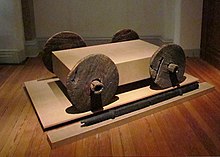
Glum disc wheels

Stade bronze wheels around 1000 BC.
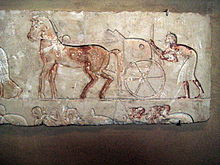
Relief of Amarna, Egypt, ca. 1345-1335 BC, Metropolitan Museum of Art, New York
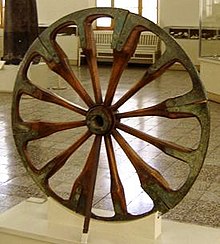
Chariot wheel from Chogha Zanbil, Iran, mid to late 2nd millennium BC National Museum Tehran
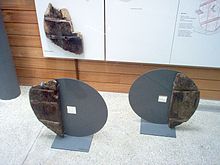
Partially preserved chariot wheels of the Goldberg III group (2900 BC) from the Federsee Basin Museum

Funnel beaker dated 3500-3350 B.C., on the left oldest known image of a chariot with wheels, find site Bronocice near Działoszyce in Poland.
Materials
For thousands of years, only wood was used as a material. The first spoked wheels had bronze spokes, in the further course of the Bronze Age and thereafter wooden spoked wheels predominated, on which only the inner surface of the wheel hub rubbing on the axle and the outer tread of the rim were plated with metal. Progress in metallurgy towards increasingly durable metals was then also used here. It was not until the invention of the steam engine and the internal combustion engine, which made higher transport capacities and speeds possible, that wheels were made entirely of iron, later welded together from sheet steel to form the rim. The lubricated hub shells were replaced by roller bearings. Wheels for low loads were of lightweight construction with wire spokes, which were pretensioned and loaded in tension.
The design of the wheels was always adapted to the surface to be travelled on (only later paths and roads), or the surface was improved in accordance with the increased requirements. This is how it was created:
- Steel hoop on wooden rim for wheels of wheelbarrows, two- or four-wheeled carts, wagons or carriages on farmland, field or plank roads or paved roads or the first commercially operated electric tram of the FOTG in Germany on rails
- Hard rubber tyre on wooden or cast iron rim for the first motor vehicles, longer also for the trucks on paved roads
- Pneumatic tyres on rims for road vehicles and aircraft on asphalt or concrete roads.
Special developments of the wheel for means of transport other than road vehicles are:
- the railway wheel with steel tyres and wheel flanges, also for cranes and escalators
- the pulleys or wheels used to support the endless hauling rope on cableways and chair or ski lifts.
Today, hard rubber tyres on steel wheels are used as support wheels, e.g. for tracked vehicles, for merry-go-rounds, for cable cars and chair lifts or for industrial vehicles such as the forklift truck.
Plastic wheels with or without metal hubs or roller bearings, often without rubber tyres, are available for mobile tables, scaffolding, ladders (also on top), furniture, lift trucks for Euro pallets and shopping trolleys (also with bars for clinging to moving walkways).
In precision mechanics, wheels, which are usually precision-manufactured from plastic, are used to transmit power, for example to switches.
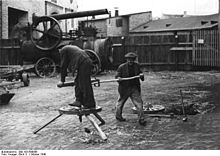
Cartwheel Repair
Questions and Answers
Q: What is a wheel?
A: A wheel is a disc or circle-shaped mechanical device that allows things to roll.
Q: What is the purpose of a wheel?
A: The purpose of a wheel is to make objects move more easily along the ground.
Q: What is the principle behind the wheel?
A: The principle behind the wheel is that of mechanical advantage.
Q: What are most land vehicles equipped with?
A: Most land vehicles are equipped with wheels.
Q: How are wheels often used?
A: Wheels are often used in pairs, connected by a rod of wood or metal known as an axle.
Q: What is the hub of a wheel?
A: The hub of a wheel is the part that attaches to the axle.
Q: What are some examples of machines that use wheels?
A: Some examples of machines that use wheels are the potter's wheel, the lathe, and the windlass.
Search within the encyclopedia